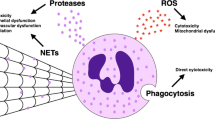Abstract
Objective: To determine whether expression of neutrophil integrin receptors is related to the degree of post-traumatic shock. Design: Data were collected prospectively on patients with major trauma admitted to the surgical intensive care unit. Setting: Denver General Hospital, Colorado. Patients and participants: 17 severely injured adults. Measurements and results: The mean fluorescence intensity and per cent positive of neutrophil integrin receptors CD11 b, CD18 and CD11 a, and systolic blood pressure, blood transfusion, lactate and base deficit as indices of shock. CD11 b expression on circulating neutrophils was increased 6 and 12 h after trauma. After correcting for the other shock indices, base deficit predicted CD11 b expression at 12 h. CD11 b expression was negatively correlated with the circulating neutrophil count. Conclusions: The degree of metabolic acidosis after trauma correlates directly with CD11 b receptor expression on circulating neutrophils. This relation may be the mechanism whereby post-traumatic shock results in neutrophil sequestration and neutrophil-mediated organ injury and failure.
Similar content being viewed by others
Author information
Authors and Affiliations
Additional information
Received: 29 July 1996 Accepted: 3 February 1997
Rights and permissions
About this article
Cite this article
Botha, A., Moore, F., Moore, E. et al. Base deficit after major trauma directly relates to neutrophil CD11 b expression: a proposed mechanism of shock-induced organ injury. Intensive Care Med 23, 504–509 (1997). https://doi.org/10.1007/s001340050365
Issue Date:
DOI: https://doi.org/10.1007/s001340050365




